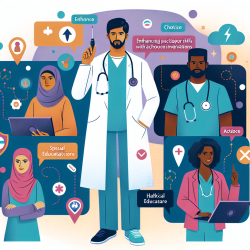Introduction
The 1918–1919 influenza pandemic, one of the deadliest pandemics in history, provides critical insights into the evolution of virulence and the dynamics of disease transmission. Understanding these insights can significantly enhance the practice of speech-language pathologists, particularly in creating effective, data-driven strategies for improving child outcomes. This blog explores the findings from the research article titled "Emerging Disease and the Evolution of Virulence: The Case of the 1918–1919 Influenza Pandemic" and discusses how practitioners can leverage these insights to refine their approaches.
Understanding Virulence: A Dual Perspective
The research highlights the importance of integrating ecological and molecular perspectives to understand virulence. Ecological perspectives focus on the interaction between hosts and pathogens, emphasizing the role of environmental conditions in disease transmission. Molecular perspectives, on the other hand, delve into the genetic and cellular mechanisms that drive virulence.
For practitioners, this dual approach underscores the need to consider both environmental and genetic factors when assessing and addressing speech and language disorders in children. By understanding the broader ecological context and the specific genetic predispositions, practitioners can tailor interventions that are more effective and personalized.
Data-Driven Decision Making
The 1918 pandemic research emphasizes the necessity of data-driven decision-making in healthcare. By analyzing the patterns of disease spread and the genetic characteristics of the virus, researchers could better understand the factors contributing to its virulence. This approach is equally valuable in speech-language pathology, where data-driven decisions can lead to more effective interventions and improved outcomes for children.
Practitioners can utilize data from assessments, progress tracking, and outcome measurements to refine their strategies. By continuously analyzing this data, they can identify trends, adjust interventions, and ensure that each child receives the most appropriate and effective care.
Encouraging Further Research
The research on the 1918 pandemic highlights the ongoing need for further investigation into the evolution of diseases and their impact on health. For speech-language pathologists, this means staying informed about the latest research in both evolutionary biology and speech-language pathology. By doing so, practitioners can incorporate new findings into their practice, leading to more innovative and effective approaches.
Encouraging collaboration between disciplines can also lead to breakthroughs in understanding and addressing complex speech and language disorders. By working with researchers in fields such as genetics, neurology, and psychology, speech-language pathologists can gain a more comprehensive understanding of the factors affecting their clients.
Conclusion
The insights from the 1918 influenza pandemic research provide valuable lessons for speech-language pathologists. By integrating ecological and molecular perspectives, making data-driven decisions, and encouraging further research, practitioners can enhance their skills and improve outcomes for children. These strategies not only lead to more effective interventions but also contribute to a deeper understanding of the complex interplay between genetics, environment, and health.
To read the original research paper, please follow this link: Emerging Disease and the Evolution of Virulence: The Case of the 1918–1919 Influenza Pandemic.










